Hungary’s inflation rate, which reached a 26-year high in the early months of 2023, is predicted to reduce household purchasing power and affect domestic demand in the country. Moreover, the high borrowing costs will likely keep investment sentiment low. In addition, the country’s export growth is anticipated to slow in line with declining external demand. Against this backdrop, the Hungarian economic growth is projected to grow at a meagre 0.04% in 2023, following a 4.79% growth in 2022, according to GlobalData, the data and analytics company.
GlobalData’s latest report, Macroeconomic Outlook Report: Hungary shows that Hungary is heavily dependent on Russia for fossil fuels, as the country imports nearly 65% of its oil and 85% of its gas from Russia. Hence, the country is experiencing an energy crisis caused by the sanctions on Russia. In October 2022, the country closed public facilities, which include theatres, spas, pools, libraries, museums, and sports venues, due to soaring energy prices as well as a gloomy economic situation.
Puja Tiwari, Economic Research Analyst at GlobalData, comments: “The industrial sector has been experiencing a gradual decline in growth since August 2022, and it contracted by 0.2% and 4.6% on an annual basis in January and February 2023, respectively. The future of this sector looks bleak due to lower external demand. Hungary’s exports rely heavily on Germany, which accounts for almost a quarter of total exports. As Germany’s economy is expected to stagnate in 2023, it will directly affect Hungarian exports.”
Hungary PR Chart.png
According to GlobalData, mining, manufacturing, and utilities contributed 24.7% to the gross value added (GVA) in 2022, followed by financial intermediation, real estate, and business activities (23.2%), and wholesale, retail trade and hotels (12.5%). In nominal terms, the three sectors are forecast to grow by 9.7%, 9.9%, and 9.6%, respectively, in 2023, compared to 12.2%, 12.4%, and 12.1% in 2022.
In 2022, the Hungarian forint depreciated by 22.9% against the US dollar, making it one of the poorest performing currencies in Europe. It is projected to experience a further depreciation of 3.6% in 2023, according to GlobalData. The depreciating value of the currency led to higher prices for raw materials, which in turn increased the price of final products. GlobalData forecasts the inflation rate in Hungary to increase to 17.8% in 2023 from 14.5% in 2022.
On the external side, due to the expected slowdown in its major trading partner economies, Hungary’s exports are forecast to grow at a slower pace of 3.3% in 2023 from 7.6% in 2022.
Hungary is categorized as a low-risk nation and the country ranked 41st out of 153 nations in GlobalData Country Risk Index (GCRI Q4 2022). The country’s risk score is lower in all the parameters excluding environmental risk when compared with the East European average in Q4 2022.
Tiwari concludes: “Since Hungary is trade dependent on only a few nations, diversification of its export destinations will help ease its external vulnerability. Also, the country must continue its energy transition efforts at a faster pace to achieve greater energy security amidst Russia’s invasion of Ukraine.”
 Engineer News Network The ultimate online news and information resource for today’s engineer
Engineer News Network The ultimate online news and information resource for today’s engineer




